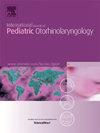Clinical significance and audiological outcomes in bilateral microtia: Simultaneous auricle reconstruction and BONEBRIDGE implantation via retrosigmoid sinus approach
IF 1.2
4区 医学
Q3 OTORHINOLARYNGOLOGY
International journal of pediatric otorhinolaryngology
Pub Date : 2025-03-24
DOI:10.1016/j.ijporl.2025.112324
引用次数: 0
Abstract
Objective
To evaluate the effectiveness and safety of using the retrosigmoid sinus approach for BONEBRIDGE implantation in patients undergoing auricle reconstruction with tissue expansion flap.
Methods
44 patients who accepted BONEBRIDGE implantation through the retrosigmoid sinus approach were included. Audiological outcomes were measured before and after the BONEBRIDGE implantation. Long-term hearing and complications were also evaluated.
Results
After surgery, there was no significant change in bone conduction hearing thresholds compared to pre-surgery levels. Sound field thresholds after being aided with BONEBRIDGE showed a significant decrease of 27.2 dB HL. Speech recognition scores of monosyllabic words, disyllabic words, and short sentences in quiet environments significantly increased to 72 %, 84 %, and 98 %, respectively. During the 8–51 months follow-up, audiological results remained stable, and all patients were satisfied with the aesthetics of auricle reconstruction.
Conclusion
Patients with bilateral microtia, undergoing auricle reconstruction with expanded postauricular flap, were chosen for the retrosigmoid sinus approach during BONEBRIDGE implantation and achieved safety, good hearing results as well as improved aesthetics.
双侧小耳畸形的临床意义及听力学结果:乙状窦后入路耳廓重建及骨桥植入
目的评价乙状窦后入路在耳廓扩张皮瓣再造术中骨桥植入术的有效性和安全性。方法对经乙状窦后入路行骨桥植入术的44例患者进行分析。在骨桥植入前后测量听力学结果。同时对长期听力及并发症进行评估。结果术后骨传导听力阈值与术前相比无明显变化。BONEBRIDGE辅助声场阈值显著降低27.2 dB HL。在安静环境下,单音节单词、双音节单词和短句的语音识别得分分别显著提高到72%、84%和98%。随访8-51个月,听力学结果稳定,所有患者对耳廓重建术美观满意。结论双侧小耳症患者在骨桥植入术中选择乙状窦后入路行扩展耳后皮瓣耳廓再造术,安全性好,听力效果好,美观性好。
本文章由计算机程序翻译,如有差异,请以英文原文为准。
求助全文
约1分钟内获得全文
求助全文
来源期刊
CiteScore
3.20
自引率
6.70%
发文量
276
审稿时长
62 days
期刊介绍:
The purpose of the International Journal of Pediatric Otorhinolaryngology is to concentrate and disseminate information concerning prevention, cure and care of otorhinolaryngological disorders in infants and children due to developmental, degenerative, infectious, neoplastic, traumatic, social, psychiatric and economic causes. The Journal provides a medium for clinical and basic contributions in all of the areas of pediatric otorhinolaryngology. This includes medical and surgical otology, bronchoesophagology, laryngology, rhinology, diseases of the head and neck, and disorders of communication, including voice, speech and language disorders.

 求助内容:
求助内容: 应助结果提醒方式:
应助结果提醒方式:


